A SmartHood is a neighborhood in which all food, water and energy flows are circularly connected. As a resident of a SmartHood, you generate all your electricity and heat sustainably, purify your own (sewer) water for reuse, and grow your own vegetables and fish through an aquaponics system. Continue reading to know more about this innovative urban development!
(Scroll down for Dutch)
1. How does the solution work?
A SmartHood is a neighbourhood in which all food, water and energy flows are circularly connected. As a resident of a SmartHood, you generate all your electricity and heat sustainably, purify your own (sewer) water for reuse, and grow your own vegetables and fish through an aquaponics system. All these systems work closely together to form an as efficient, sustainable and self-sufficient as possible. For example, black (sewer) and gray water are used to generate biogas, which is then converted into heat, electricity and CO2 in a cogeneration plant. The electricity and heat are then used to illuminate and heat the houses, while the CO2 can be used to make the greenhouse plants of the aquaponics system grow faster.
Because of this high degree of sustainable self-sufficiency, your ecological footprint is immediately reduced by about 40%. A SmartHood serves as a blueprint for the neighborhood of the future: high-tech, circular and decentralized.
Figure 1: Schematic representation of the SmartHoods system, with electricity flows in red, red heat flows, blue water flows, and green biomass / food flows.
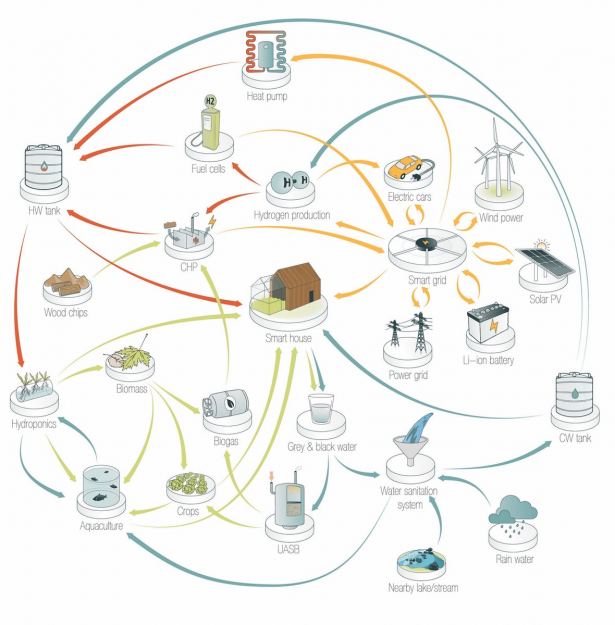
In addition, the SmartHoods concept also deals with the planning and policy aspects of a self-sufficient neighbourhood with a decentralized infrastructure. How do you create a viable neighbourhood that is both sustainable and resilient, without being bothered by hard-to-turn choices ("lock-ins"), as is the case with the natural gas network? This requires a holistic approach in which all possible decisions must be carefully weighed against each other with an eye on the future. Additionally, thanks to the decentralization of utilities, new social models will have to be developed for living in a SmartHood. How, for example, is the responsibility divided between having to operate and manage the local systems? For example, residents of a SmartHood could collectively arrange this, making them both the owner and end-user of their own energy, food, and water supply. This increases their self-sufficiency and autonomy and their direct involvement with their neighbourhood.
2. How does it contribute to the energy objectives?
Thanks to the high degree of system integration, it is possible to achieve an extremely high degree of local self-sufficiency. Current calculation models show a potential self-sufficiency of renewable electricity and heat of well above 90%. For instance, a zero-on-the-meter house fitted with solar panels will eventually only consume around 30% of the generated electricity, the remaining 70% will be fed back into the grid. The local balancing of energy is essential for the energy transition, because it relieves the grid so that more space is created for the large-scale roll-out of renewable energy sources such as wind and sun.
The SmartHood solves problems not only in the field of energy, but also in the area of water and food supply. For example, a closed phosphate cycle is possible thanks to the aquaponics system (fish and food production in a closed system) and the gray / black water purification plant in combination with bio-digester and struvite reactors. Closing the phosphate cycle is, just like the energy transition, one of the greatest challenges of the 21st century, because there is only a limited stock while all food production depends on it (i.e. artificial fertilizer). It is estimated that phosphate production will peak in 2030, while global food needs will increase by 60-100% by 2050.
The decentralization that a SmartHood entails requires many adjustments to current utilities. They will no longer be able to centrally regulate the production and distribution of, for example, drinking water and electricity. It is therefore questionable which new models of ownership will arise, and which new roles utilities will play in this.
3. What is needed to realize the solution in Amsterdam?
At this moment the SmartHoods concept is still in the research phase. We look at how we, together with progressive partners such as the WUR, Metabolic, Spectral, Waternet, Municipality of Amsterdam and Alliander, can develop the concept in such a way that it is not only theoretical, but also practically feasible. Existing innovative urban area developments such as the Ceuvel, Hotel Amstelkwartier and Schoonschip will be analysed to this end in order to map the local flows of raw materials (i.e. urban metabolism). Together with the parties involved, we will then look at the possibilities for new urban area developments to be adapted to the SmartHoods concept. This will not only involve new developments in technical, but also in policy, planning and economic fields. Ultimately, the SmartHoods concept has the potential to offer an extremely sustainable and viable alternative to new urban area development.
----------------------------------------------
1. Hoe werkt de oplossing?
Een SmartHood is een wijk waarin alle voedsel, water en energiestromen circulair met elkaar verbonden zijn. Als inwoner van een SmartHood wek je al je stroom en warmte duurzaam op, zuiver je je eigen (riool)water om deze te kunnen hergebruiken, en kweek je je eigen groenten en vis door middel van een aquaponics-syteem. Al deze systemen werken nauw samen om een zo efficient, duurzaam, en zelfvoorzienend mogelijk geheel te vormen. Zo worden zwart (riool) en grijs water bijvoorbeeld gebruikt om biogas op te wekken, wat vervolgens in een warmtekrachtkoppeling omgezet wordt in warmte, elektriciteit en CO2. De elektriciteit en warmte worden vervolgens gebruikt om de huizen te verlichten en te verwarmen, terwijl de CO2 gebruikt kan worden om de kasplanten van het aquaponics systeem sneller te laten groeien.
Door deze hoge mate van duurzame zelfvoorzienendheid wordt je ecologische voetafdruk direct met zo’n 40% verlaagd. Een SmartHood dient dan ook als blauwdruk voor de wijk van de toekomst: high-tech, circulair en decentraal.
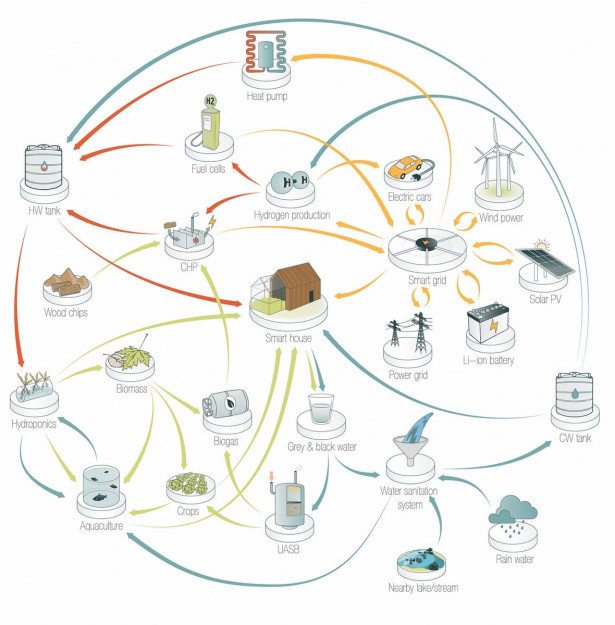 Figuur 1: Schematische weergave van het SmartHoods systeem, met in geel de elektriciteitsstromen, rood de warmtestromen, blauw de waterstromen, en groen de biomassa/voedselstromen.
Figuur 1: Schematische weergave van het SmartHoods systeem, met in geel de elektriciteitsstromen, rood de warmtestromen, blauw de waterstromen, en groen de biomassa/voedselstromen.
Daarbovenop houdt het SmartHoods concept zich ook bezig met de planologische en beleidsmatige aspecten van een zelfvoorzienende wijk met decentrale infrastructuur. Hoe creëer je een leefbare wijk die zowel duurzaam als veerkrachtig is, zonder dat je later in de knel komt te zitten door moeilijk terug te draaien keuzes (“lock-ins”), zoals nu bijvoorbeeld bij het aardgasnetwerk het geval is? Dit vergt een holistische aanpak waarbij alle mogelijke besluiten zorgvuldig tegen elkaar afgewogen moeten worden met oog op de toekomst. Ook zullen er dankzij het decentraliseren van de nutsvoorzieningen nieuwe sociale modellen moeten worden ontwikkeld voor het leven in een SmartHood. Hoe wordt bijvoorbeeld de verantwoordelijkheid verdeeld van het opereren en beheren van de lokale systemen? Inwoners van een SmartHood zouden dit bijvoorbeeld collectief kunnen regelen, waardoor ze zowel eigenaar als eindgebruiker worden van hun eigen energie- voedsel- en watervoorziening. Dit vergroot zowel hun zelfvoorzienendheid/autonomie als hun directe betrokkenheid bij het leven in de wijk.
2. Hoe draagt het bij aan de energiedoelstellingen?
Dankzij de hoge mate van systeemintegratie van een SmartHood is het mogelijk om een extreem hoge graad van lokale zelfvoorzienendheid te realiseren. Huidige rekenmodellen laten een potentiële zelfvoorziening van duurzame elektriciteit en warmte van ruim boven de 90% zien. Ter vergelijking: een nul-op-de-meter huis voorzien van zonnepanelen zal uiteindelijk maar rond de 30% van de opgewekte stroom zelf consumeren, de overige 70% wordt terug het net ingevoerd. Het lokaal balanceren van energie is van essentieel belang voor de energietransitie, omdat daarmee het net wordt ontlast zodat er meer ruimte wordt gecreëerd voor de grootschalige uitrol van duurzame energiebronnen zoals wind en zon.
Niet alleen op het gebied van energie, maar ook op het gebied van water en voedselvoorziening lost de SmartHood problemen op. Zo is er een gesloten fosfaatkringloop dankzij het aquaponics systeem (vis- en voedselproductie in een gesloten systeem) en de grijs/zwartwater zuiveringsinstallatie i.c.m. biovergister en struvietreactor. Het sluiten van de fosfaatkringloop is, net als de energietransitie, een van de grootste uitdagingen van de 21 eeuw, omdat er maar een beperkte voorraad is terwijl alle voedselproductie ervan afhankelijk is (kunstmest). Naar schatting zal de fosfaatproductie in 2030 pieken, terwijl de mondiale voedselbehoefte met 60-100% zal toenemen tot 2050.
De decentralisatie die een SmartHood met zich meebrengt vergt veel aanpassingen van de huidige nutsbedrijven. Niet langer zullen zij de productie en distributie van bijvoorbeeld drinkwater en stroom centraal kunnen regelen. Het is dan ook de vraag welke nieuwe modellen van eigenaarschap zullen ontstaan, en welke nieuwe rollen de nutsbedrijven hierin zullen spelen.
3. Wat is er nodig om de oplossing in Amsterdam te realiseren?
Op dit moment zit het SmartHoods concept nog in de onderzoeksfase. Er wordt gekeken hoe we samen met vooruitstrevende partners zoals de WUR, Metabolic, Spectral, Waternet, Gemeente Amsterdam en Allianderhet concept op zo’n manier kunnen ontwikkelen dat het niet alleen theoretisch, maar ook praktisch haalbaar is. Bestaande innovatieve stedelijke gebiedsontwikkelingen zoals de Ceuvel, Hotel Amstelkwartier en Schoonschip zullen hiertoe geanalyseerd worden om zo de lokale grondstoffenstromen (urban metabolism) in kaart te brengen. Samen met de betrokken partijen zal er vervolgens gekeken worden naar de mogelijkheden voor nieuwe stedelijke gebiedsontwikkelingen om aangepast te worden naar het SmartHoods concept. Dit zal niet alleen nieuwe ontwikkelingen op technisch, maar ook beleidsmatig, planologisch en economisch gebied met zich meebrengen. Uiteindelijk heeft het SmartHoods concept de potentie om een uiterst duurzaam en leefbaar alternatief te bieden voor nieuwe stedelijke gebiedsontwikkeling.
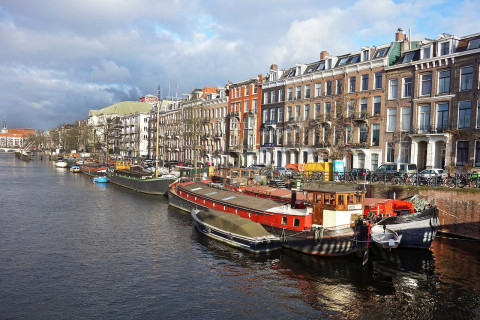
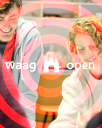
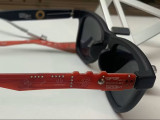



@nancyzikken Yes klopt, spread the word dacht ik ;)
Hi Florijn, ik begreep dat je dit artikel ook via Reddit gedeeld hebt! Dit heeft een paar honderd bezoekers naar dit artikel getrokken vorige week :)
Wat ben je goed bezig zoon, trots